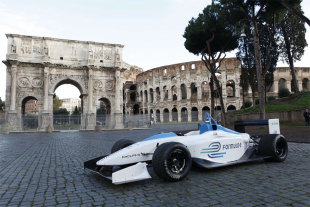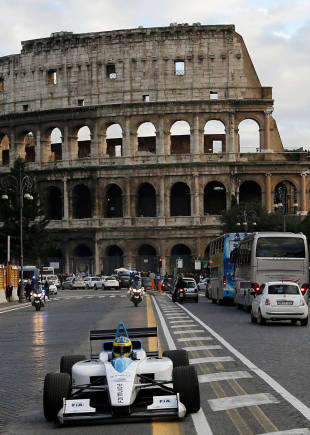- GP Week
Are friends electric?

For a championship that is setting its sights on bright lights amidst towering, vibrant cities, Silverstone seemed like an odd place to meet the powerbrokers behind the FIA Formula E Championship.
Unlike London, Rio, Los Angeles or Rome, the home of the British Grand Prix - neatly bordering the counties of Northamptonshire and Buckinghamshire - is a tranquil venue indeed. Outside, an early summer evening draws in and chills develop as the natural light dims and a breezy calm takes hold.
Almost typical for the region are the weighty grey clouds, which have still to decide whether to spill their contents or merely threaten. Inside Silverstone's new Wing auditorium and conference room, a very different atmosphere is gaining ground.
Leaning forward under spotlights, Alejandro Agag thinks for a moment, considering his words carefully: "We have to be modest." The 42-year-old business draws a somewhat shallow breath, before adding, "We are not going to fix the world, [but] we think we can contribute a little to fix the CO2 problems in cities..."
When the European Commission asked the FIA to introduce a racing championship for electric cars just over two years ago in order to increase awareness of the technology, President Jean Todt, alongside former BMW director Burkhard Goeschel, set about laying the foundations of what would eventually become Formula E.
Determining that this new series needed to be single-seater in nature in order to feed public interest, Formula E Holdings (FEH) was launched in August 2012 with the aim of taking the category to select city centres around the world. With former MEP Agag heading FEH as CEO, things have moved quickly for the series.
So far nine cities have signed up, following the recent announcement of Bangkok as a host city. Specific dates will not emerge until September at the earliest, following a meeting of the World Motor Sport Council. The car design - penned by Spark Technologies - recently reached completion, with Dallara expected to begin building up to forty chassis units in the coming months.
Earlier this month, Renault were announced as the series' technical partner, while Tag Heuer will present timing and scoring and last week, MediaCom was unveiled as Formula E's marketing and communications agency. Like it or not, Formula E is coming.
Meanwhile, at Silverstone, it soon becomes clear that there is a confidence to Agag as he acknowledges the category's manifesto. When asked why single-seaters represent such a key image for Formula E, the Spaniard is clear and forthright. "We think the single-seater aspect is very important for our championship. We want single-seater racing in city centres, because we think the electric cars have a problem, which is perception."
As owner of the Addax teams that compete in the GP2 and GP3 Series respectively, Agag is by no means a novice to motorsport. If anything, his credentials have served to add weight to the vision of Formula E. "To change perception, we wanted to show cars that are cool, fast and racey and that, we think, may change - this may have a very relevant effect on the perception people have about electric cars. We want to increase the number of electric cars in cities - that is the endgame of this championship and for that we think the showcase of single-seaters is a good one."
Aston Martin chairman and Prodrive boss Dave Richards agrees: "The interesting thing about motorsport and the general public and people buying motor cars is that they only buy things that they think will be an advantage to them and motorsport is a wonderful environment to demonstrate technologies that become part of everyday motor cars or a period of time. It will be a new form of technology, especially for those living in cities."
Naturally, the series has had its critics. Due to limited battery life, drivers will need to complete a mandatory pitstop mid-race to change into a second car - a feature that garnered much eye rolling and snide remarks from within the industry. For Agag, this regulation is a necessary evil, but which he hopes may drive battery technology forward. "The solution was to either put two cars [per driver] or to wait 10 years for when the batteries would be ready to last longer. We decided to not wait and we wanted to show the development - first they last 25 minutes, then 30 and on; it will show that these batteries are progressing."
The subject of technological development catches the attention of Drayson Racing Team Principal, Lord Paul Drayson. "We have been pioneering green technology in motorsport since 2007, and with the electric car you are faced with getting to know new technology operating at the limits of its performance."

We've had 125 years to push that performance with the internal combustion engine, yet we are just scratching the surface of what we can do with hybrids and pure electric drivetrains, but the most exciting element is the opportunity to make motorsport much more relevant to the challenges of the car industry."
A passionate devotee to motorsport, the former UK government minister believes that perception of engineering in motorsport will also benefit from the birth of Formula E: "There's never been a better time to be a motorsport racing engineer. If motorsport can show that it can use the crucible of competition to develop better batteries and better electric motors and show in racing how well they work, then we can change the perception of these challenges."
Of course, Formula E will be far from a unique project. There has been a growing amount of electric racing in Europe and the US of late. In a field filled with all-electric Andros smart cars, the third Grand Prix de Electrique took place at Pau last week - with FIA GT racer Mike Parisy taking his second victory in the event ahead of GP2 Series regular Nathanael Berthon. Audi DTM factory driver Adrien Tambay won the event in 2012.
Away from the streets of southern France, students competing in Formula School have made numerous inroads into electric and alternative energy motor racing, while Indiana's Purdue University hosted its fourth EV Grand Prix this month. Agag, however, is looking at a concept far larger than those projects: "We have been overwhelmed with the response [...] and the level of interest from leading drivers and teams who share our vision for the future in combining exciting racing with clean energy and sustainability."
Richards also sees benefits for manufacturers who may be eyeing up Formula E: "The one thing I find intriguing is the opportunity for manufactures, like Prodrive, to develop new technologies and to showcase them in a relevant environment. Around 80 percent of our work focuses on activities other than motorsport, and a lot of these activities revolve around battery technology and hybrid systems, so to be able to apply that technology in racing and have it without constraints is going to be an exciting opportunity for us," says the former BAR boss.
"We are going through so many one make formulas now where you can't innovate and the engineers haven't got the latitude to show their talents and the manufacturers to show new technologies."
Just before the discussion draws to a close, Agag elicits one final thought: "I think it is important that motorsport is taking this lead. Who knows where the future will take us? We can imagine in 20 or 30 years that we will look back and think how strange it was that we lived in cities where all these cars were throwing smoke. Today we can go to a restaurant and not be surprised that no one is smoking!"
Society is constantly developing and adapting to new challenges. Who is to say Formula E or a series like it won't frame the future of motorsport?

